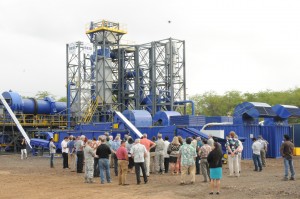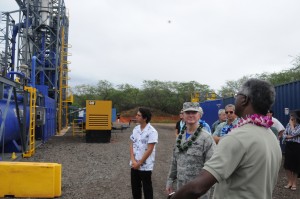New $6.8 Million Waste-to-Energy System Unveiled

Joint Base Pearl Harbor-Hickam: demonstration site of a new $6.8 million renewable and clean, waste to energy generating system.
The High Technology Development Corporation’s Hawaiʻi Center for Advanced Transportation Technologies sponsored a demonstration of a $6.8 million renewable and clean, waste to energy generating system today.
The demonstration runs through this summer at Joint Base Pearl Harbor-Hickam on Oʻahu, near the campus of the Hawaiʻi Air National Guard, and was done through a contract with Biomass Energy Systems, Inc.
The waste to energy project demonstration showcases the efficacy of converting 10 tons of waste per day to electricity using a state-of-the art gasification technology.
The Air Force Research Labs selected the Hawaiʻi Air National Guard’s 154th Wing to demonstrate an integrated microgrid concept that tests the viability of using renewable energy and microgrids to assure that the Air Force can continue mission critical operations regardless of the state of the public utility grid or cyber-attack. Phase I of the microgrid will utilize a rotary kiln gasifier that turns waste into fuel, heat and electricity.

Joint Base Pearl Harbor-Hickam: demonstration site of a new $6.8 million renewable and clean, waste to energy generating system.
“The Air Force’s effort to develop a microgrid testbed in Hawaii will help ensure that the Air National Guard has access to the energy it needs to execute its defense and homeland security missions, while providing a proof of concept that clean energy and microgrid technologies can support the Air Force’s broader energy security goals,” said Sen. Brian Schatz in a joint press release announcement.
Schatz, who was identified as being instrumental in convincing the Air Force to select Hawaiʻi as a demonstration site, officiated over the demonstration ceremony.
JBPHH was selected based on Hawaiʻi’s variety of renewable energy sources, the high cost of electricity and complexity of the Hawaiʻi Air Guard’s 154th Wing, which operates the F-22, the most advanced fighter in the US inventory.
HCATT Director, and former HIANG Commander Brigadier General Stan Osserman said, “This demonstration signifies an important step toward energy security and Net Zero goals for waste, not only for the military, but for civilian populations throughout the islands, and even beyond.”
The waste to energy project represents an investment by the Air Force to determine the feasibility of solving the challenge of waste disposal with the opportunity to offset the cost of electricity on base.
The system at JBPHH is designed to handle between two and 10 tons of waste per day and generate a net 200 to 300 kW of baseload power using four generators run from the syngas produced by the gasifier.
“The system is clean, reliable and rugged,” said Renee Comly, president and CEO of BESI, the company that built the system. “We are pleased to demonstrate how a system like this can be a real asset as we move towards a world run on clean energy,” said Comly.
The BESI rotary kiln system was installed at JBPHH in December 2015 and has completed all of its initial testing this month. It will begin running specific “recipes” for several weeks to collect data using specific “feed-stock” that can be expected from a military base with a population of about 2000 people.
The system will then be tested on its ability to produce hydrogen that can be used in fuel cell vehicles already being demonstrated at JBPHH. It will then be used to produce a liquid jet fuel from waste. Eventually, the Air Force plans to include the gasifier in the first phase of its micro-grid project at the end of this year.










